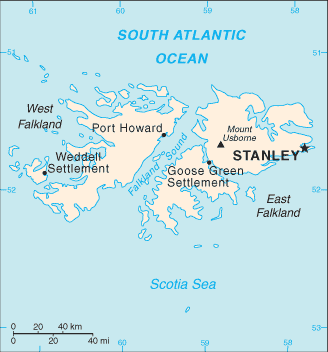Port Howard

Port Howard (Spanish/Argentine name: Puerto Mitre; sometimes Puerto Howard in Spanish) is the largest settlement on West Falkland (unless Fox Bay is taken as one settlement, instead of two). it is in the east of the island, on an inlet of Falkland Sound. It is on the lower slopes of Mount Maria (part of the Hornby Mountains range).
Port Howard is the centre of a 200,000 acre (800 km²) sheep farm, with twenty permanent residents and over 42,000 sheep. Sometimes this population is doubled by transitory residents.
The settlement has two airstrips which receive regular flights from Stanley, and it is also the West Terminal of the new East-West Ferry. Over the past 15 years the Falkland Islands Government has built a network of all weather roads around East and West Falkland, Port Howard is at the Northern end of the West Falkland network. Attractions in the settlement include a golf course, a ford, and large sheep shearing sheds. There is also a dairy here. Many of the houses have attractive green roofs, and there are also a number of hedges about.
Every three years, Port Howard hosts the West Falklands Sports. This week-long celebration of the end of the shearing season combines serious horse-racing with other festivities.
The Warrah River and Chartres River are nearby fishing rivers.
History

Port Howard was founded by James Lovegrove Waldron, and his brother in 1866; the Waldron brothers later left for Patagonia, but left the farm under local management. In 1986, it was bought by Robin and Rodney Lee, who let the local population buy shares. [1]
In 1956, JL Waldron Ltd built a school at Port Howard, possibly inspired by the "gift" of the FIC at Darwin, a few years earlier.[2]
There is one listed building here, the Mount Rosalie Dip. [3]
Falklands War
During the Falklands War, the settlement was occupied by around 1,000 Argentine troops. A small museum has been set up, in a shed. It contains a number of items which Argentine troops left behind, including an ejector seat. Pinned to the wall, is a poem, Ode to Tumbledown which was written by an anonymous Scots Guard. [1]
The British SAS had a secret observation post on Many Branch Point, a ridge above Port Howard, which was discovered on 10 June, by an Argentine Assault Section, part of 601 Commando Company. During the ensuing fire fight, Captain John Hamilton was killed, and his Goan signaller, Sergeant Fonseca captured. [4] That night witnessed the inaccurate shelling carried out by British frigates on Port Howard[5]. It led to speculation among Argentinian officers that the mission of Hamilton was to act as Naval Gunfire Support Forward Observer (NGSFO). Hamilton's grave can still be seen up the hill from Port Howard. Unusually, the Argentines allowed for the Union Flag to be placed on his coffin before burial, in recognition for his perceived bravery.
The garrison surrendered to HMS Cardiff on June 15, 1982 (one day after the main Argentine surrender).[6]
References
- ^ a b Wigglesworth, Angela. (1992) Falkland People. Pub. Peter Owen. ISBN 0-7206-0850-3
- ^ Strange, Ian (1983) The Falkland Islands
- ^ "Falkland Islands Information Web Portal". Buildings and Structures in the Falkland Islands designated as being of Architectural or Historic Interest. Retrieved 2008-07-08.
- ^ Bicheno, Hugh (2006) Razor's Edge: The Unofficial History of the Falklands War. London. Weidenfield & Nicholson. ISBN 978-0-7538-2186-2
- ^ Apenas había concluído esta tarea cuando se escuchó una explosión, que en un primer momento fue atribuída al estallido de una mina. Pero al rato se percibieron claramente tres cañonazos navales y todos buscaron cubiertas: los observadores ubicados en Monte María, atrás y arriba de Howard, indicaron posteriormente que se trataba de tres fragatas desde la distancia habitual de diez a doce kilómetros. El bombardeo duró hasta las tres de la mañana y fue muy impreciso: le faltaba observación. El teniente primero Fernández supuso que el primer disparo, aislado, fue un llamado al observador, al no recibir su comunicación: y los posteriores se limitaron a dirigirlos hacia las posiciones previamente marcadas -la ubicación de la Compañía B, sobre un cerro-, pero sin causar efectos. Ruiz Moreno, pp. 345-346
- ^ "Report of Proceedings". hmscardiff.co.uk. Retrieved 2008-02-12.
